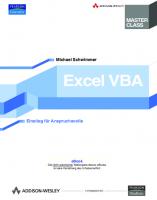The Art of VBA Mastery: A Cureated Expert Guide For VBA In Finance: Master VBA for Finance in 2024
Reactive Publishing Unleash the full potential of your financial analysis and reporting with 'The Art of VBA Maste
149 93 3MB
English Pages 945 Year 2024
Table of contents :
Title Page
Dedication
Contents
Foreword
Chapter 1: Introduction to Advanced VBA in Finance
1.1 The Role of VBA in Modern Finance
1.2 Setting Up the Development Environment
1.3 Best Practices in VBA Coding
1.4 Understanding VBA Syntax and Structure
1.5 Advanced Excel Object Model
Chapter 2: Financial Data Analysis with VBA
2.1 Importing and Exporting Data
2.2 Data Cleaning and Transformation
2.3 Advanced Techniques for Data Analysis
2.4 Dynamic Reporting with VBA
2.5 Data Visualization and Charting Techniques
Chapter 3: VBA for Financial Modeling
3.1 Building Flexible Financial Models
3.2 VBA Functions for Financial Calculations
3.3 Automating Sensitivity and Scenario Analysis
3.4 Risk Analysis and Management with VBA
3.5 VBA Techniques for Optimization
Chapter 4: Database Management and SQL with VBA
4.1 Introduction to SQL and Relational Databases
4.2 Writing SQL Queries within VBA
4.3 Automated Data Storage and Retrieval
4.4 Database Reporting and Analysis
4.5 Integrating VBA with SQL Server and Access
Chapter 5: User Interface and User Experience in Financial Tools
5.1 Custom Form Design and Best Practices
5.2 Building Interactive Dashboards and Controls
5.3 Advanced Control Techniques
5.4 User Experience Optimization
5.5 Securing User Interfaces
Chapter 6: Automating Excel Tasks with VBA
6.1 Task Automation Basics
6.2 Advanced Workbook and Worksheet Management
6.3 Event-Driven Programming
6.4 Scheduling and Timing Tasks
6.5 Integrating Excel with Other Office Applications
Chapter 7: Error Handling and Debugging
7.1 Principles of Error Handling
7.2 Debugging Techniques for VBA
7.3 Writing Custom Error Handlers
7.4 Testing and Validation Techniques
7.5 Optimization and Performance Tuning
Chapter 8: Advanced Financial Functions and Procedures
8.1 Creating Custom Financial Functions
8.2 Complex Calculations and Algorithms
8.3 Date and Time Functions for Financial Analysis
8.4 Statistical and Mathematical Techniques
8.5 Developing Complex Financial Indicators
Chapter 9: Financial Simulation and Risk Modeling
9.1 Understanding Stochastic Processes in Finance
9.2 Monte Carlo Simulation Techniques
Conclusion
Glossary Of Terms
Additional Resources
Epilogue: The Art of Possibility through Automation
Afterword
Title Page
Dedication
Contents
Foreword
Chapter 1: Introduction to Advanced VBA in Finance
1.1 The Role of VBA in Modern Finance
1.2 Setting Up the Development Environment
1.3 Best Practices in VBA Coding
1.4 Understanding VBA Syntax and Structure
1.5 Advanced Excel Object Model
Chapter 2: Financial Data Analysis with VBA
2.1 Importing and Exporting Data
2.2 Data Cleaning and Transformation
2.3 Advanced Techniques for Data Analysis
2.4 Dynamic Reporting with VBA
2.5 Data Visualization and Charting Techniques
Chapter 3: VBA for Financial Modeling
3.1 Building Flexible Financial Models
3.2 VBA Functions for Financial Calculations
3.3 Automating Sensitivity and Scenario Analysis
3.4 Risk Analysis and Management with VBA
3.5 VBA Techniques for Optimization
Chapter 4: Database Management and SQL with VBA
4.1 Introduction to SQL and Relational Databases
4.2 Writing SQL Queries within VBA
4.3 Automated Data Storage and Retrieval
4.4 Database Reporting and Analysis
4.5 Integrating VBA with SQL Server and Access
Chapter 5: User Interface and User Experience in Financial Tools
5.1 Custom Form Design and Best Practices
5.2 Building Interactive Dashboards and Controls
5.3 Advanced Control Techniques
5.4 User Experience Optimization
5.5 Securing User Interfaces
Chapter 6: Automating Excel Tasks with VBA
6.1 Task Automation Basics
6.2 Advanced Workbook and Worksheet Management
6.3 Event-Driven Programming
6.4 Scheduling and Timing Tasks
6.5 Integrating Excel with Other Office Applications
Chapter 7: Error Handling and Debugging
7.1 Principles of Error Handling
7.2 Debugging Techniques for VBA
7.3 Writing Custom Error Handlers
7.4 Testing and Validation Techniques
7.5 Optimization and Performance Tuning
Chapter 8: Advanced Financial Functions and Procedures
8.1 Creating Custom Financial Functions
8.2 Complex Calculations and Algorithms
8.3 Date and Time Functions for Financial Analysis
8.4 Statistical and Mathematical Techniques
8.5 Developing Complex Financial Indicators
Chapter 9: Financial Simulation and Risk Modeling
9.1 Understanding Stochastic Processes in Finance
9.2 Monte Carlo Simulation Techniques
Conclusion
Glossary Of Terms
Additional Resources
Epilogue: The Art of Possibility through Automation
Afterword

- Author / Uploaded
- Strauss
- Johann; Bisette
- Vincent; Van Der Post
- Hayden
- Similar Topics
- Computers
- Software: Office software









